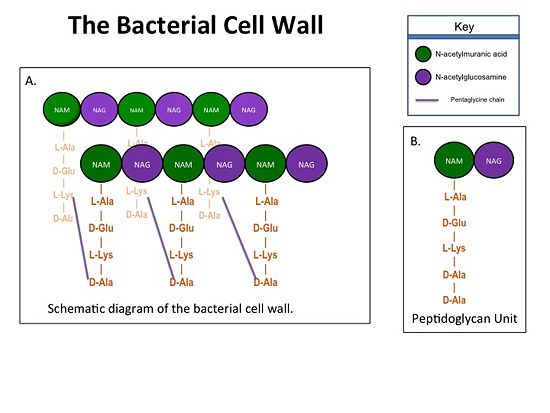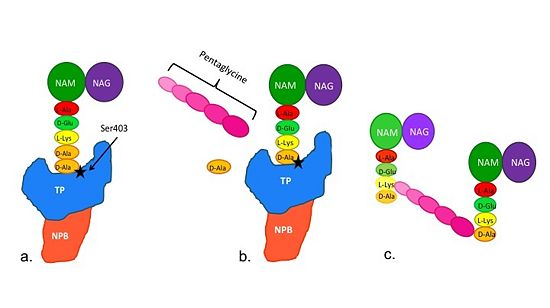Sandbox 124
From Proteopedia
IntroductionPeptidoglycan transpeptidases, also known as penicillin-binding proteins (PBP), catalyze the cross-linking of peptidoglycan polymers during bacterial cell wall synthesis. Beta-lactam (β-lactam) antibiotics, which include penicillins, cephalosporins and carbapenems, bind and irreversibly inhibit transpeptidases. The overuse and misuse of β-lactam antibiotics has led to strains of Staphylococcus aureus that are resistant to all β-lactams and are often only susceptible to “last resort antibiotics”, such as vancomycin.
Cell Wall StructureThe cell wall, which is composed of peptidoglycans, is crucial for maintaining the structural integrity of the bacterium. Peptidoglycans consists of N-acetylmuramic Acid (NAM) and N-acetylglucosamine (NAG) polymers. Rows of peptidoglycan are cross-linked together with pentaglycine chains. The NAM residues have a five amino acid side chain that terminates with two D-Alanine (D-Ala) residues.
Structure of a Resistant TranspeptidaseMethicillin resistant Staphylococcus aureus (MRSA) is resistant to all β-lactams because it acquires an alternative PBP, PBP2a, that is not bound or inhibited by any β-lactams. PBP2a is composed of two domains: domain and a domain. The NBP domain of PBP2a is anchored in the cell membrane, while the TP domain “sits” in the periplasm with its active site facing the inner surface of the cell wall. The active site contains a serine residue at position 403 ()which catalyzes the cross-linking of the peptidoglycan rows with pentaglycine cross-links.
Catalytic Mechanism of PBP2a(a) The D-Ala-D-Ala side-chain substrate of the peptidoglycan accesses the active site of the PBP2a. (b) Ser403 nucleophilically attacks the peptide bond of the terminal D-Ala residues of the substrate. The terminal D-Ala residue then exits the active site. The now terminal D-Ala residue forms a covalent bond to Ser403, while a crosslinking pentaglycine chain enters the active site. (c) A covalent bond forms between the pentaglycine chain and the terminal D-Ala residue, regenerating the active site serine residue. The entire process takes 4 milliseconds. How Do Antibiotics Work?The β-lactam antibiotics inhibit bacterial growth by inhibiting PBPs and ultimately cell wall synthesis. Specifically, β-lactams are molecular mimics of D-Ala-D-Ala, which is the normal substrate of PBPs. Nucleophillic attack of the β-lactam results in the PBP being irreversibly inhibited by the β-lactam. As a result, the synthesis of the cell wall is inhibited which leads to cell lysis.
PBP2a and CeftobiproleMRSA becomes resistant to β-lactams by acquiring an alternative PBP, PBP2a, that is neither bound nor inhibited by β-lactams. Recently, two cephalosporins – and ceftaroline – that have anti-MRSA activity have been developed. Ceftobiprole is able to inhibit PBP2a because additional chemical groups at the position of the cephalosporin backbone are able to interact with additional amino acid residues in PBP2a; specifically . As a result of ceftobiprole to PBP2a as highlighted in green , , shown as colors of the atom types (CPK), is able to more efficiently react with the serine active site residue and therefore inhibit the activity of PBP2a. | ||||||||||||



